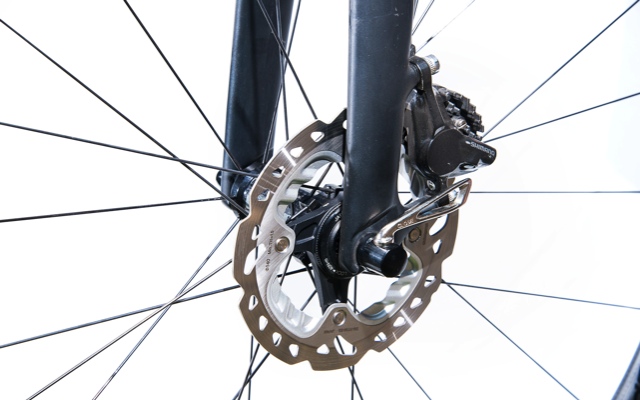Specialized S-Works Tarmac with disc brakes – review
How will the top-of-the-range disc version of the Specialized Tarmac fare with our reviewer?

The weirdest thing about riding the S-Works Tarmac Disc isn’t looking down and seeing the disc brake rotor – it’s seeing how dished the front wheel is to make room for it.
Close your left eye and you see what looks like a standard front wheel, with spokes angled out towards the right side of the hub. But close your right eye and you barely see the spokes on the left at all.
In order to accommodate the rotor and keep the rim centred on the hub, the front wheel has to be laced with an asymmetrical spoke angle, similar to how the rear wheel is laced to accommodate the cassette. Although these modifications are necessary, are disc brakes on road bikes really necessary?
The short answer is no, not really. If you’ve got alloy rims and calliper brakes that are well maintained and adjusted, then you won’t be missing out on much. But the short answer doesn’t tell the whole story – if you’re running carbon rims for the weight and/or aero advantages, you’ll be aware that braking isn’t their strong point, especially in the wet. And this is where the case for disc brakes is made: discs provide consistent, powerful braking for carbon wheels, whatever the weather.
Disc brakes really come into their own if you’re running carbon rims
Precise and powerful
The case for disc brakes is like the case for shaving your legs. Bare legs make it easier to clean and dress crash wounds. But since you don’t know when you’re going to crash, in order to enjoy that benefit you have to keep shaving your legs! Similarly, you can’t be sure when you’re going to be racing in the wet on carbon wheels. So if you want the benefit of good braking under those circumstances you have to put up with having discs the rest of the time too.
But what’s the braking like in these particular circumstances, on the S-Works Tarmac Disc? Well, if you’re used to calliper brakes, it’s a little different but perfectly fine. The Shimano 785 discs are precise and powerful and bring you to a halt with none of the grabby, on-or-off feel you usually get from callipers on carbon rims.
Do they stop you faster than rim brakes? Without measuring by the side of the road it’s hard to tell. The most noticeable difference is the lack of visual reference. With rim brakes you can see your front calliper close onto the wheel in your peripheral vision. It’s not a big movement but you can see when the force is about to be applied. With disc brakes, any movement is hidden away at the bottom of the fork so it’s harder to tell when the brake will bite, especially as there’s quite a bit of throw in the lever before contact is made. It’s by no means a problem but it takes some getting used to.
Hydro-electric power
As for the rest of the bike, the S-Works Tarmac – with discs or without – is a real showstopper. And it comes with a show-stopping eight-grand price tag, which is a huge amount considering that it’s ‘just’ a race bike. It’s not an aero road bike, it’s not a tri bike, it’s not a flyweight climbing bike or a flexible rough-roads bike; it’s purely and simply a race bike. But it’s a great one – a no-expense-spared, uncompromised competition machine.
The frame is made with Specialized’s 11r FACT (‘functional, advanced, composite technology’) blend of carbon fibre, which is light, solid as a rock and responsive to every pedal input. All the usual stiffening suspects are present – the tapered head tube, oversized down tube and big bottom bracket shell. Combined they form an amazing pedalling platform that seems to want to do nothing other than go as fast as it can.
The Tarmac disc is a do-it-all, no-expense-spared racing machine
As well as supplying the hydraulic disc brakes, Shimano also supply the majority of the groupset in the form of their electric 11-speed Dura-Ace Di2 set-up. Aside from the shift buttons being a bit small and the extra hassle of having to charge it every now and then, it’s a set-up that’s difficult to fault, whether you’re a mechanical purist or not.
The only non-Shimano parts in the drivetrain are the Specialized FACT crankset and CeramicSpeed press-fit bottom bracket. But while Shimano handles the lion’s share of the groupset, the rest of the bike is dressed with Specialized’s own components. Saddle, seatpost, stem, bars, wheels and tyres are all taken care of by Specialized. Our only bone to pick is with the wheels from their in-house brand Roval.
Yes, they’re carbon; yes, they’re deep-section; and yes, they’re disc-brake compatible. But even though their rim profiles are not especially deep (40mm on the front and back wheels), they’re an easy target for crosswinds. If only Specialized could fully address this, the S-Works Disc would be an almost unfaultable racing machine.
Apart from that, the only other criticism is the remarkably bulbous heads atop the brake levers. This is to accommodate the disc brakes (in this case the master cylinder in the levers), but it leaves the normally very stylish levers looking a little bloated.
Verdict: A fine showcase for disc brakes but, with or without the discs, a show-stopping bike with a big ticket price, 93%
Contact : www.specialized.com




